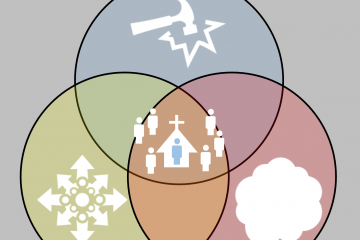This post is based on some work I did with a few friends back in 2009. I never got round to publishing it back then, but it’s been on my mind recently… We wanted to produce a rough list of different models so that fresh expressions or shared ministry churches would have some ideas to draw on.
The Need for a Team
Every Christian community committed to shared ministry needs some form of team who will be responsible for coordinating and enabling the ministry of the community as a whole. This group should not be seen as a leadership team – although it will play a role in leadership. Neither should it be seen as a ministry team – although members will each exercise their own ministry. The role of the team is to help all members of the community to fulfil their call to be ministers and leaders as part of the body of Christ.
There are various forms of team which could be considered. It is important that everyone is clear about the function, purpose and membership of the team and this must be agreed as part of the scheme.
Here are some possible models:
A. Team of Ministers
In this model the team would consist of those who are already authorised as ministers by their denomination.
The strength of this model is that everyone has been trained and is accountable.
The weakness is that it reinforces the distinction between “professionals” and “amateurs”.
For some communities a Team of Ministers might provide a stepping stone toward a more genuinely shared approach.
B. Team of Teams
In this model the team would be formed by those who coordinate, convene or support teams, committees or interest areas. For example a community might set up groups to work in the following areas: outreach, worship, hospitality, education, administration and pastoral care. The six groups would all be represented in the team. The people who do this could be the conveners of the groups or nominated representatives.
The advantage of this model is that it encourages involvement and a sense of interconnection. It also places responsibility in the hands of local people.
The disadvantage is that it could become little more than a committee structure.
Communities would also need to think about how authorised ministers would relate to the team. Would they be members of the team – or of the teams and groups – or a bit of both…
C. Staff Team
In this model the team consists of people who have been elected, authorised, appointed or employed to take on certain functions within the community.
For instance, the team could consist of an administrator, youth worker, pastoral assistant, organist and caretaker.
The advantages of this model would be that the team would reflect the work of the community. It would also help connect the people who are actually making things happen.
The disadvantages would be that those who are part of the team may find that they are also doing most of the work.
It would be important for the community to decide how any “professional” ministers would function as part of the team.
A staff team is a bit like a team of ministers and has similar strengths and pitfalls. It would be important for the team to remember that they are called to help others rather than do everything themselves…
D. Elected Team
In this model the team would consist of those who were elected by community members. The team might be the church council or function alongside the council.
Team members would have clearly defined responsibilities which might include pastoral care, collective leadership, administration and worship. Such a team might resemble a group of elders in the Presbyterian system.
This model would have several advantages and may be less beurocratic than a Team of Teams. The focus for team members would be on ministry rather than administrative duties.
The disadvantages of this model would be the potential for implicit hierarchy and status – and for ministry to be focused on the team rather than the community.
E. Vocational Team
In this final model the team is neither elected, nor appointed. Team members are not selected because they have existing roles but are called out from the community through a process of discernment and prayer.
Members of the team will then explore their own calling as they seek to help others do the same.
This model has advantages in that it creates the possibility for further development.
On the other hand, it may be a little too vague and open-ended to be effective in many contexts.
None of these models are perfect and a community will need to spend some time working out which model (or combination of models) is most appropriate for their circumstances. They will also need to decide what name should be given to their team since titles can be significant. Options may include Servant Leadership Team, Ministry Support Team, Ministry Development Team and so on…







